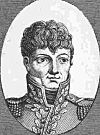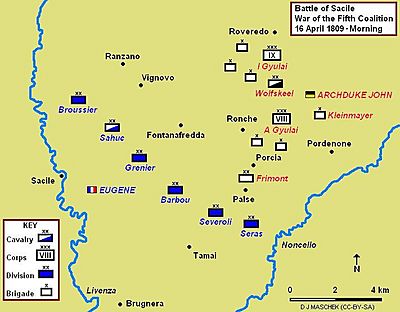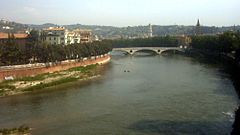Battle of Sacile facts for kids
Quick facts for kids Battle of Sacile |
|||||||
|---|---|---|---|---|---|---|---|
| Part of the War of the Fifth Coalition | |||||||
 Porcia, the focus of major fighting |
|||||||
|
|||||||
| Belligerents | |||||||
| Commanders and leaders | |||||||
| Strength | |||||||
| 37,050, 54 guns | 39,000, 55-61 guns | ||||||
| Casualties and losses | |||||||
| Pordenone: 2,500, 4 guns Sacile: 6,500, 19 guns |
Pordenone: 253 Sacile: 3,846-4,100 |
||||||
The Battle of Sacile was an important fight during the War of the Fifth Coalition in 1809. It happened on April 16, 1809, near Sacile in modern-day Italy. Before this, a smaller fight called the Clash at Pordenone took place on April 15. In these battles, an Austrian army led by Archduke John of Austria defeated a combined French and Italian army. This army was commanded by Eugène de Beauharnais, who was Emperor Napoleon I's stepson.
In April 1809, Archduke John quickly moved his army into northeastern Italy. On April 15, at Pordenone, the Austrian advance guard (the first group of soldiers) easily beat the French rear guard (the last group of soldiers), causing many losses for the French. Even after this, Eugène thought his army was bigger than the Austrians. So, he attacked the Austrians near Sacile the next day. Both sides had about the same number of foot soldiers. However, the Austrians had twice as many cavalry (soldiers on horseback), which helped them win the battle.
After the defeat, Eugène pulled his army back about 130 kilometers (80 miles) to a strong defensive spot at Verona. This city is located on the Adige river. There, he reorganized his army and got more soldiers. At Verona, the French and Italian army was safe from Archduke John's army coming from the east. They were also safe from another Austrian group threatening them from the Tyrol in the north. By the end of April, news of French victories in another area, the Danube valley, made Archduke John retreat to the east. Eugène then followed him.
Contents
Why Did They Fight?
Austria's Plan
In early 1809, the Austrian Empire decided to go to war against Emperor Napoleon I's First French Empire. Austria gathered its main army in the Danube valley. This army was led by Archduke Charles, Duke of Teschen. Even though Italy was not the main battleground, Archduke Charles and the Austrian high command (called the Hofkriegsrat) sent two army groups to Italy. They put Archduke John in charge.
Some historians say Archduke John was not a very good commander. His first army was completely defeated by French General Jean Victor Marie Moreau in 1800. However, he did better in the War of the Third Coalition in 1805. After Napoleon defeated another Austrian army, John's army quickly retreated. He managed to join up with his brother Archduke Charles's army. But Napoleon won a huge victory at the Battle of Austerlitz, which ended the war before they could help.
For the 1809 war, Archduke John had two main army groups. One had about 24,500 infantry and 2,600 cavalry. The other had about 22,200 infantry and 2,000 cavalry. John planned for these two groups to meet near Cividale del Friuli. Before the war started, the region of Tyrol had a rebellion against the Bavarians. Archduke Charles ordered John to send about 10,000 Austrian troops to help the Tyrolese rebels. This meant John's army in Italy was a bit smaller than planned.
France's Plan
Napoleon knew that Austria might start a war. So, he sent more soldiers to the Army of Italy. This army was led by his stepson, Eugène de Beauharnais. The French army in Italy grew to about 70,000 soldiers. Many of these "French" soldiers were actually Italians, as parts of Italy were controlled by France.
Before 1809, Eugène had never led a large group of soldiers in battle. But Napoleon trusted him with the Army of Italy. Napoleon sent many detailed letters to Eugène, telling him how to defend Italy. He advised Eugène to retreat if the Austrians attacked with more soldiers. He said that the Adige river was a very important place to defend. Napoleon didn't think Austria would attack in April. He also didn't want to make Austria angry by gathering his armies too early. Because of this, Eugène's army was spread out across northern Italy.
First Moves
Archduke John's Austrian army invaded Italy on April 10, 1809. One part of his army came through Tarvisio, and another crossed the Isonzo River. The Austrians marched very quickly. They captured Udine on April 12. Eugène wanted to gather his army behind the Tagliamento river. He told two of his divisions to slow down the Austrians. But they couldn't stop John's fast advance.
Even so, Eugène believed his army was strong enough to win. So, he ordered his divisions to gather at Sacile, which is on the Livenza River. Because of the rebellion in Tyrol, Eugène sent an Italian division to Trento to help. By April 14, Eugène had six divisions near Sacile. However, some of his other divisions and cavalry were still far away. Before the war, Eugène had asked Napoleon if he could organize his infantry into larger groups (corps), but Napoleon hadn't replied. This meant Eugène's army fought as many separate divisions, which made it harder to control during the battle.
The Battle
You can see how both armies were set up in the Sacile 1809 order of battle.
Fight at Pordenone
On April 15, Eugène ordered his army to cross the Livenza River. French divisions moved through Sacile. Other divisions crossed at Brugnera and headed towards Tamai. Another division crossed north of Sacile. Meanwhile, a French rear guard, made of light cavalry and infantry, was about 12 kilometers (7.5 miles) east of Sacile near Pordenone. French scouts reported that Archduke John's troops had crossed the Tagliamento. But Eugène didn't know exactly how strong the Austrian army was.
Archduke John, thanks to his own scouts, knew a lot about the French army. He ordered his advance guard to attack the French at Pordenone in the morning. At 6:00 am, the Austrians fought with the French cavalry. Austrian infantry attacked the town, making the French stretch their soldiers to defend. French cavalry tried to attack the Austrians from the side, but they were surprised and quickly defeated by Austrian cavalry. Without cavalry support, the French infantry in Pordenone had to retreat.
The Austrians lost about 250 soldiers killed or wounded at Pordenone. The French lost much more: about 500 killed or wounded, and 2,000 soldiers captured. They also lost 4 cannons. Many French soldiers surrendered, and their regiment lost its flag.
Main Battle at Sacile
Archduke John knew the French were gathering at Tamai. So, he placed his VIII Army Corps and advance guard to defend Pordenone and Porcia. His IX Army Corps, which arrived late on the 15th, camped just west of Pordenone. John planned to hold off French attacks on Porcia with his left side. Then, he would send his IX Army Corps to attack the French center.
Eugène still didn't know that the IX Army Corps was there. He thought he was only fighting about 20,000 Austrians. He even said, "In one day I will retake all of the territory I have abandoned." He knew the Austrians had more cavalry. So, he decided to attack the Austrian left side, where the ground was not good for cavalry.
At 9:00 am, Eugène's attack began with an artillery barrage. His two divisions quickly took Palse and started attacking Porcia. The Austrians sent their cavalry, which slowed down the French. This gave Archduke John time to send his VIII Army Corps to counterattack. This attack almost broke one of the French divisions. But then, another French division joined the fight and pushed the Austrians out of Porcia. Seeing his attack struggling, Eugène moved more of his troops to the right side of the battle.
Meanwhile, the Austrian IX Army Corps began its planned move. Around noon, they reached Roveredo and then attacked the French center. The IX Army Corps threatened to overwhelm the French. The French quickly moved soldiers to defend their center. There was fierce fighting in the middle of the battlefield. Eugène refused to use his cavalry because the Austrians had so many more. During this difficult time, the French lost Porcia to another Austrian attack.
Seeing that his main attack had failed, Eugène ordered a retreat at 5:00 pm. On the right side, French and Italian troops covered the withdrawal. Some historians believe that a large Austrian cavalry attack could have crushed the retreating French. But the Austrian general kept his cavalry behind his infantry. This allowed the French divisions to retreat in good order, supporting each other. They finally reached the Livenza River after many small fights with the chasing Austrians. Nightfall helped them cross the river safely. The rest of the French army crossed the next morning.
What Happened Next?
The French and Italian army lost about 3,000 soldiers killed or wounded at Sacile. Another 3,500 soldiers, 19 cannons, and two flags were captured by the Austrians. The Austrians lost about 3,600 killed or wounded and 500 captured.
Archduke John decided not to chase the French right away. His VIII Army Corps had been badly hurt near Porcia, and his cavalry was tired. Instead, he sent only his advance guard to follow the French. Some historians think that John's failure to chase the French was a big mistake.
After the battle, Eugène used his fresh divisions to protect his retreating army. He also sent soldiers to strengthen the defenses of Venice. This forced John to send some of his own troops to watch Venice. The French and Italian army held the line of the Piave River for four days. But then they fell back towards the Brenta River on April 21. When the Austrian army reached Verona on April 28, they found Eugène in a very strong defensive position behind the Adige River.
Napoleon was very angry about Eugène's defeat. He even thought about replacing him. But by the time his letter arrived, Eugène was already moving forward again. Eugène had gathered more soldiers as he retreated, so his army grew to 60,000 men at the Adige. Meanwhile, John's army got smaller because he had to send troops to watch Venice and help the Tyrolese rebels. News of Napoleon's victory over Archduke Charles in another battle made Archduke John retreat back towards Austria in early May. The next battles between John and Eugène were the Battle of Caldiero and the Battle of Piave River.
|







